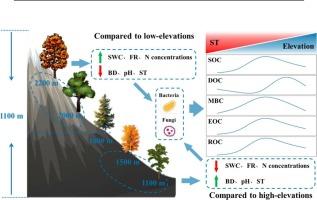Critical role of mid-elevation in microbial regulation of soil carbon dynamics on the southern foothills of the Qinling Mountains
IF 5.7
1区 农林科学
Q1 GEOSCIENCES, MULTIDISCIPLINARY
引用次数: 0
Abstract
Soil microbial communities play a crucial role in regulating the spatial distribution of soil carbon along elevational gradients in mountain ecosystems. However, consensus remains limited on how habitats at different elevations influence microbial regulation of soil organic carbon (SOC) and its constituent fractions. In this study, we investigated microbial and environmental controls on SOC dynamics along an elevational gradient (1100–2200 m a.s.l.) on the southern foothills of the Qinling Mountains, China. We assessed the composition and abundance of soil microbial communities, key carbon fractions (dissolved organic carbon [DOC], microbial biomass carbon [MBC], easily oxidizable carbon [EOC], and recalcitrant organic carbon [ROC]), and associated environmental parameters across three soil depths (0–20, 20–40, and 40–60 cm). Regression analyses revealed that SOC, MBC, EOC, and ROC exhibited quadratic (concave-down) relationships with elevation across all soil layers. In contrast, DOC concentrations remained relatively stable in surface soils (0–20 cm) but increased with elevation in deeper layers (40–60 cm). Soil microbial communities displayed distinct spatial patterns along the elevational gradient. Redundancy analysis and stepwise regression models indicated that DOC variation was more strongly regulated by soil physicochemical properties than by biological factors. Soil total nitrogen, soil moisture, bacteria, and fungi were identified as important regulators of other SOC fractions. Notably, fungi demonstrated greater environmental tolerance than bacteria, and stable mid-elevation habitats promoted soil C accumulation by fungi. However, surface runoff loss and microbial consumption of available substrates were greater at both high and low elevations, leading to decreased soil C contents at these elevations. Overall, this study highlights the importance of comprehending the role of elevational gradients in regulating microbe-mediated soil C sequestration in mountain ecosystems in response to climate change.

中高海拔在秦岭南麓微生物调控土壤碳动态中的关键作用
土壤微生物群落在调节山地生态系统土壤碳沿海拔梯度的空间分布中起着至关重要的作用。然而,不同海拔生境对微生物调控土壤有机碳及其组分的影响尚不明确。本文研究了微生物和环境对秦岭南麓土壤有机碳动态的影响,研究了海拔梯度(1100 ~ 2200 m a.s.l.)。我们评估了土壤微生物群落的组成和丰度、关键碳组分(溶解有机碳[DOC]、微生物生物量碳[MBC]、易氧化碳[EOC]和难氧化有机碳[ROC])以及3个土壤深度(0-20、20-40和40-60 cm)的相关环境参数。回归分析表明,土壤有机碳、MBC、EOC和ROC与海拔高度呈二次曲线关系。表层土壤(0 ~ 20 cm) DOC浓度相对稳定,但深层土壤(40 ~ 60 cm)随海拔升高而升高。土壤微生物群落沿海拔梯度呈现出明显的空间格局。冗余分析和逐步回归模型表明,土壤理化性质对土壤DOC变化的调控作用强于生物因子。土壤全氮、土壤水分、细菌和真菌是其他有机碳组分的重要调节因子。值得注意的是,真菌比细菌表现出更强的环境耐受性,稳定的中高海拔生境促进了真菌对土壤C的积累。然而,地表径流损失和有效基质的微生物消耗在高海拔和低海拔都更大,导致这些海拔的土壤C含量下降。总的来说,本研究强调了理解海拔梯度在调节微生物介导的山地生态系统对气候变化的土壤碳封存中的作用的重要性。
本文章由计算机程序翻译,如有差异,请以英文原文为准。
求助全文
约1分钟内获得全文
求助全文
来源期刊

Catena
环境科学-地球科学综合
CiteScore
10.50
自引率
9.70%
发文量
816
审稿时长
54 days
期刊介绍:
Catena publishes papers describing original field and laboratory investigations and reviews on geoecology and landscape evolution with emphasis on interdisciplinary aspects of soil science, hydrology and geomorphology. It aims to disseminate new knowledge and foster better understanding of the physical environment, of evolutionary sequences that have resulted in past and current landscapes, and of the natural processes that are likely to determine the fate of our terrestrial environment.
Papers within any one of the above topics are welcome provided they are of sufficiently wide interest and relevance.
 求助内容:
求助内容: 应助结果提醒方式:
应助结果提醒方式:


